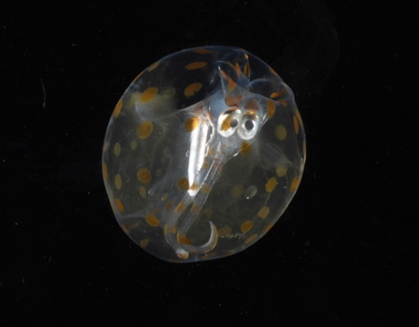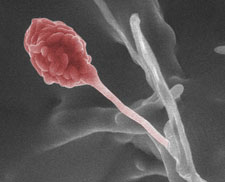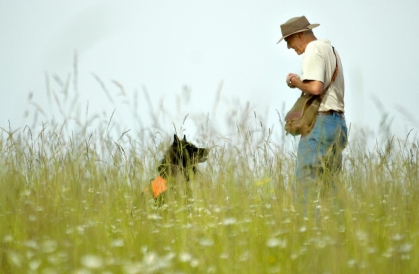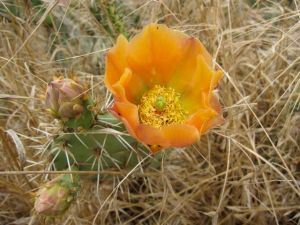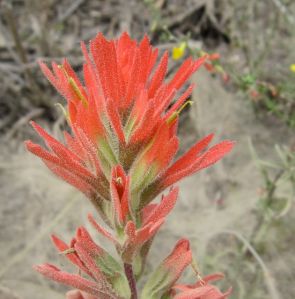Filed under: Uncategorized
….But Not very Far.
Please visit Biophilia Blog at http://biophiliablog.wordpress.com/
Filed under: Nerdy News
Sorry for the recent lack of posts….I’ve been back in the classroom and away from the blog, trying to convince a large group of non-majors why biology is cool. Here are a few headlines that distracted me from doing actual work caught my eye this week:
- Stars of the deep: A biological voyage to the unexplored water of the Mid-Atlantic range just returned and revealed a wealth of unexplored biodiversity — including a rare basket star, a swimming sea cucumber and a moutaineering sea cucumber, an electric blue worm and a blind, brainless, purple, primitive worm that me be the link between those of us with backbones and those of us without.
- Still gushing: As of today (Sunday), it’s been a horrible 83 days since BP ruined the Gulf. The flow of oil is currently unimpeded as BP attempts to install a new cap. If you’re in a good mood today and hope to maintain that happy feeling, then do not click here to read the projected path of the oil over the next 365 days (Mom: it might be a good time to sell your NY beach house).
- The Secret Love Life of Fireflies: The spectacular display of fireflies has a purpose — they produce bioluminescence as a mating tool where males cruise around looking for chicks while displaying a very specific pattern of flashes. In fact, some fireflies do this synchronously, sometimes lighting up a whole forest all at once (spectacular!), and now we have evidence that this complex behavior helps females to recognize males of her own species by “eliminating the visual clutter” of other flashing males. Check it out in this week’s issue of Science.
- Another Reason to Step Away From the Computer: Go for a “Forest Bath”. Forest Bathing has become a popular therapeutic practice in Japan, and scientists are finding that being amongst plants decreases pulse rate and lowers blood pressure and may even increase white blood cells. Of course this could be linked to stress reduction, but scientists are proposing that is is related to phytoncides — airborne chemicals that plants emit to protect them from rotting and insects.
- Help the Itty Bitty Kitty’s: Consider heading over to my favorite blog and taking Butterbean’s Daily Donation Challenge to support the Tacoma Humane Society.
Introducing Teuthowenia megalops, or as my trusted source for cuteness calls it, Eddie McBlobbules, “the inside-out-seahorse-in-a-ball-nerd of the deep”.
Actually, he is a paralarval squid that is found in the North Atlantic Ocean. The polka dots that add to his cuteness are actually chromatophores — a special type of pigment-containing, light-reflecting cell that helps certain animals (fishes, cephalopods, amphibians, crustaceans) to camouflage or communicate.
Once again, Fungi may come to the rescue! A study published by Strobel et al. found that the endophyte Gliocladium roseum produces a complex mixture of volatile hydrocarbons and derivatives that closely resemble those found in fossil fuels. Dr. Strobel has been called the “Indiana Jones of Fungus Hunters” because of his forays into the wild to search for for fungi with novel bioactive compounds. This biofuel-producing endophyte was discovered living in trees the Patagonian rainforest. According to Strobel, the combination of fuel substances produced by G. roseum are unique and promising. Even better is that this fungus is producing hydrocarbons directly from cellulose — a far better source of biofuel than anything we use at the moment. I look forward to the day that I can power up my car with this “myco-diesel!
Endophytes are sneaky little buggers. Relatively little is known about them because they live their life hidden inside plants (more specifically, in between plant cells!). But unlike pathogens, they do not produce symptoms or signs to alert us to their presence. They are extremely common (found in almost every plant species we’ve looked for them in) but their relationships with plants are not well understood. They might be good for their plant partners — they can create a barrier to keep attackers at bay. Or, they can be bad for their plant partners — plant leaves with lots of endophytes tend to lose a greater amount of water.
Why be a fungus hunter? Endophytes are a major source of bioactive compounds, including antiobiotics. For example, Dr. Strobel discovered a specimen that grows on the Yew tree that produced Taxol, the world’s first billion- dollar anti-cancer drug.
(oh, and by the way, taxol can be isolated from both the plant AND the fungus, suggesting some horizontal gene transfer is going on here!)
Click here to read about some of the other compounds produced by endophytic microbes that have been studied in Strobel’s lab.
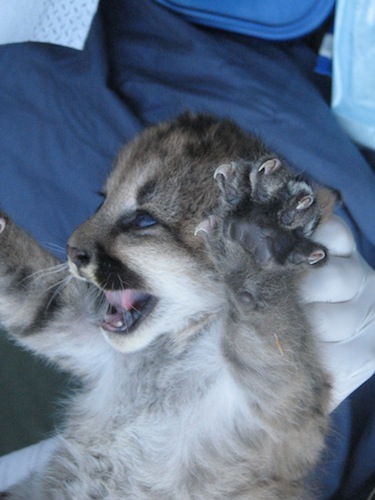 Both photos via National Park Service
Both photos via National Park Service
A litter of 3 mountain lions (Puma concolor) was born late last month in the Santa Monica Mountains….the first documented litter in 6 years!!! The National Park Service has been tracking a population of about 19 mountain lions in the Santa Monica Mountains, Simi Hills and Santa Susana Mountains to better understand how they live amidst so much development.
The birth of the kittens is exciting for reasons other than just cuteness. Their father made headlines in spring of 2009 after he successfully crossed (over? under?) Highway 101 to enter the mountains last spring…..bringing new genetic material along with him. Here in Southern California, there is limited open space and a serious lack of wildlife crossings that allow for safe passage to other wild areas to the north and west. This can lead to conflicts over territory and often results in inbreeding within the confined mountain lion population….so the “new genetic material” is a welcome contribution. The National Park Service is informing project proposals that are currently under way to establish a safe and effective wildlife crossing point (a.k.a. habitat corridor) under Highway 101.
Filed under: Threats to biodiversity
*Data from U.S Fish and Wildlife Service
I’ve been working on my husband for quite some time now to let me adopt a dog. This week’s reason is that I would feel oh-so-much safer in the house on those long lonely nights when he is fishing until midnight. He’s entirely unconvinced. We all know about the variety of jobs that our domesticated friend can perform for us — rescue dogs search for missing persons, seeing-eye dogs help the blind….on a recent trip to Mexico I watched a dog walk the conveyor belt sniffing every piece of luggage for the faint trace of blood. These feats aren’t enough to convince my hubby…..but wait! There’s more! Biologists are now working with dogs to solve a variety of scientific dilemmas.
Looking to initiate an invasive plant management strategy?? Set this guy loose at your site.
A study just published in Invasive Plant Science and Management showed that trained dogs outperformed humans in their ability to detect invasive plant species. This weed outcompetes native plant species and causes both ecosystem and economic destruction, but it is often difficult to control the plant if you can’t find it! Enter Fido! Dogs are more accurate than humans (overall success rate of 81% compared to humans 59%) at locating the invasive week and could find it from much greater distance.
Kincaid’s Lupine, a rare, endangered, Oregonian plant, is the one plant on which the endangered Fender’s blue butterfly will lay its eggs.Conservationist have been working with the belgian sheepdog Rogue to spot this endangered plant and the tiny eggs laid there by the blue butterfly. Rogue and his buddies made only 5 errors in a total of 378 plots.
Of course the possibilities are endless. “EcoDogs” are being used to sniff out a variety of different endangered species – plants and animals alike! Sophie, a 15-month-old black Labrador retriever, is trained to find scat from eastern spotted skunks, while Bishop, a 3-year-old black Labrador retriever, is trained to find scat from striped skunks in Alabama. Both have been trained through EcoDogs, a collaborative organization that trains “detection dogs for ecological research”.
If you happen to be on the Puget Sound this summer and see Gator with a stiff body, mouth open, tail erect, and nose twitching it’s because he just smelled a killer whale pooping nearby! Gator’s first class nose can also detect black bear, grizzly bear, lynx, bobcat, puma, maned wolf, wolverine, fisher, marijuana, cocaine, heroin, and crack —and all he wants in return is to play with his ball.

Dogs have also been reported to sniff out low blood sugar and skin cancer. They can identify prostate cancer from urine samples. A study published in Intergrative Cancer Therapies in 2006 report that, in a matter of weeks, “ordinary” household dogs could be trained to accurately distinguish breath samples of both lung and breast cancer patients from those who were cancer-free.
Now, if you were my husband….wouldn’t you be convinced???
Oh, and if you’re ready to adopt a dog, check your local shelter or animal rescue! If you’re here in orange county check out Friends of Orange County’s Homeless Pets.
Filed under: Diversity in the animal world
Happy Dad’s Day to all the father’s out there who invest more than just their genetic material in their offspring! Like, for instance, nature’s Mr. Mom: the male seahorse.
It’s actually quite common for male fish to play the dominant parenting role, but fish in the family Syngnathidae (which includes pipefish, seahorses and sea dragons) take fathering to a whole new level: Pregnancy! When seahorses mate, the female deposits her unfertilized eggs into the male’s brood pouch (an external structure that grows on the body of the male), after which the male then releases sperm into the pouch to fertilize the eggs.
But he’s not just passively carrying around embryos; the male closely controls the prenatal environment of the embryos in his pouch by keeping blood flowing around the embryos, controlling the salt concentrations in the pouch, and providing oxygen and nutrition to the developing offspring. He does all this until they hatch, then releases fully formed, miniature seahorses into the water. What a good dad!
For other examples of good fathers in the Animal Kingdom, check out the National Geographic Slide Show.
…that you don’t know what you’ve got till it’s gone” -Joni Mitchell
I’ve been procrastinating writing a post on the oil spill. My thoughts about it are just too overwhelming to articulate. It is a disaster. At this point, we cannot even guess at the magnitude of this catastrophe; we are getting better estimates (??) of the amount of oil released but still don’t know how far it will travel and how it will be chemically and physically transformed.
These questions are too big for me to tackle. Instead, I will do what I do best — focus on some of the organisms that are, or will be, affected by one of the greatest environmental disasters of our time.
If you haven’t seen the pictures yet of what is going on above the surface, then you’re not paying attention. But what about the organisms we can’t see? For example, just last year, Prosanta Chakrabarty, an ichthyologist at Louisiana State University, discovered two new species of pancake batfish in museum collections and later caught specimens of both during bottom trawls in the northern Gulf of Mexico. We’re unlikely to see these guys on the cover of Time Magazine next to oil-covered Brown Pelicans, but they are pretty charismatic in their own right. They are found hanging around at depths down to 400 meters, hopping along the sea floor on their pelvic fins instead of swimming. With an unknown amount of oil below the surface encroaching on their habitat, it is questionable whether these newly-discovered animals will be able to weather the impact.
In the last few weeks, 228 dead sea turtles and 29 dead marine mammals have been found in the Gulf of Mexico. The oil-slicked Brown Pelican, a bird that has come back from the brink , has become a poignant symbol of this tragedy. And what about the clams, mussels, and corals that live on the deep sea floor of the gulf? Or the polychaete tubeworms that can grow up to several meters long and can live for centuries? The marsh grasses and organisms that reside in the coastal sediment?
And yes, I am well aware of the consequences of the spill on human health and well-being, and the livelihoods of so many people….but that is a topic for another day.
For now, click here to read more on the “Science of the Oil Spill”
You’ll never hear me complain about the rain here in Southern California — the wetter the better. We were spoiled this past winter and the evidence is hard to miss. For months now, the hillsides have been dotted with an explosion of color. The peak of flowering has passed, but it was a great spring to traipse around Orange County parks and observe the bounty –lupines, shooting stars, CA buttercup, and popcorn flowers to name just a few.
If you haven’t had a chance to explore, don’t worry! Many wildflowers are still going strong and you have a bit more time before the summer heat kicks in. Here are just a few lovelies I saw yesterday on a hike through El Moro Canyon in Crystal Cove State Park:


